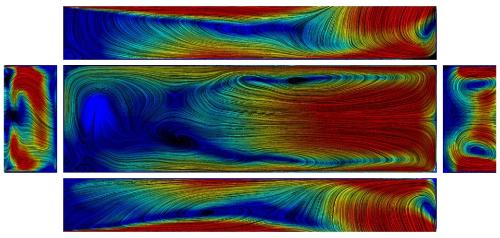Transonic Cavity Flow
The next-generation of uninhabited air vehicles carry stores in internal bays for stealth. This has a drawback that once the bays are exposed they act as resonant cavities producing substantial noise and vibration. This complex flow problem is usually studied using idealised configurations of flows inside rectangular cavities exposed to a stream of high speed flow. Strong interactions arise from the shear layer formed across the cavity and the acoustic waves radiated from the downstream cavity wall. This feedback mechanism can be seen using numerical schlieren that highlights the complexity of the flow-field inside the cavity. The computations are demanding since these require long time-histories of the flow to be captured for the flow statistics to be extracted. Computations of the idealised cavity typically require CFD grids of about 5 million cells but this size increases with the Reynolds number and the complexity of the flow geometry.

The current project uses turbulence simulation methods including Detached-Eddy Simulation and Scale-Adaptive Simulation to resolve this very turbulent, energetic flow field. The cost of turbulence simulation is high due to having to resolve a range of flow scales from small to large and short-lived to long-lived. The current project has utilised both the N8 HPC system and the Chadwick system of the University of Liverpool.

Publications
Book Chapters
- S.V. Babu, G. Zografakis and G.N. Barakos, Evaluation of Scale-Adaptive Simulations for Transonic Cavity Flows. Notes on Numerical Fluid Mechanics and Multidisciplinary Design: A European Effort on Hybrid RANS-LES Modelling. 2014
Journal Papers
- S.V. Babu, G. Zografakis and G.N. Barakos, Evaluation of Scale-Adaptive Simulations for Transonic Cavity Flows. International Journal of Engineering Systems Modelling and Simulation. International Journal of Engineering Systems Modelling and Simulation. Accepted, 2014.
Papers in Conference Proceedings
- S.V. Babu, F. Dehaeze and G.N. Barakos, Understanding Store Loads using DES and Strongly-Coupled Aeroelastic Simulations. 52nd AIAA SciTech Aerospace Sciences Meeting, Maryland, DC, 13-17 January, 2014.
- S.V. Babu, G. Zografakis and G.N. Barakos, Evaluation of Scale-Adaptive Simulations for Transonic Cavity Flows. 5th HRLM Symposium, Texas A&M University, College Station, Texas, USA, 19-21 March, 2014.
- S.V. Babu and G.N. Barakos, Prediction of Acoustics of Transonic Cavities using DES and SAS. 49th International Symposium of Applied Aerodynamics: Aerodynamics and Environment, Lille, France, 24-26 March, 2014.
- S.V. Babu and G.N. Barakos, Store Release from Cavities using Overset Grids and Scale-Adaptive Simulations. To be presented at the Royal Aeronautical Society Biennial Applied Aerodynamics Research Conference: Advanced Aero Concepts, Design and Operations, Bristol, UK, 22-24 July, 2014.
Contact
G. Barakos (Professor): g.barakos@liv.ac.uk
S. Babu (PhD Student): s.babu@liv.ac.uk
CFD Laboratory, School of Engineering
University of Liverpool
Walker Building, The Quadrangle
Liverpool L69 3GH, United Kingdom